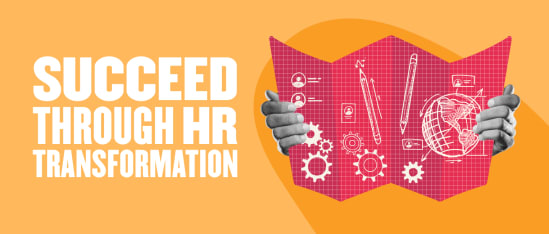HR is in the midst of a transformation. As workplaces evolve and businesses react to the tumult of recent years, company leaders are turning to HR for answers and to spearhead change. How can HR meet the charge and ensure results for all stakeholders—including investors, customers, people, boards of directors, and senior management teams?
Dave Ulrich, Professor of Business at the University of Michigan’s Ross School of Business and Partner at RBL Group, shares a practical roadmap to navigating the HR transformation and getting results in a keynote address at The HR Congress World Summit 2022 entitled “Get Results From Your HR Transformation.”
According to Dave, in our current paradigm, “HR is not about HR. It’s about helping your company succeed.” He believes that creating marketplace value is the best way HR can perform its function—and that the way to do it is through a framework of human capability built around improving outcomes in talent, organization, and leadership.
Simplify and streamline with a human capability framework
HR initiatives can often feel haphazard and all over the map. You have technology, DEI&B, leadership coaching, ESG (environmental, social, and governance), hybrid and remote work, to name just a few of the items on today’s HR departments’ to-do lists. It can be overwhelming to comprehend—and communicate—how they all relate to each other and the company’s goals.
Frameworks are a great way to cut through the clutter. Dave provides examples of widely understood frameworks that organize and simplify complicated concepts into easily digestible pieces, such as food groups, personality types, and risk assessments. Frameworks also make tracking metrics and results possible and help systematically determine areas for improvement.
He suggests a framework of human capability for the HR transformation centered around four elements: talent, organization, leadership, and HR, where HR ties the other three together. According to Dave, all HR initiatives can fit into one of these categories by determining which of the following questions they respond to:
- Talent: What should we do to have the right individual competence, workforce, or skills?
- Organization: What should we do to have the right organizational capability, workplace, or team?
- Leadership: What should we do to have the right leaders and shared leadership on all levels?
HR is responsible for delivering all three of these and generating improvements across each of them. The final piece of the puzzle is ensuring your HR department has the right people, practices, and metrics to be able to use the human capability framework to deliver value in the marketplace.
According to Dave, “An organization is not about its structure. It’s not about its hierarchy and morphology and roles. It’s not even about where people work. It’s about: ‘What do they work on?’” He thinks that in the world of hybrid work, people too often get hung up on “space and place” when they should be more focused on: “What am I working on that will help our company be successful in the marketplace and with investors?”
Work the framework: Combine actions with impact
Dave cites recent Governance and Guidance for Growth through Human Capability (G3HC) research that looks into exactly how companies can generate human capability outcomes across the entire framework. He goes deep into the data and identifies the specific actions in each category that statistics show as having the greatest impact on improving results.
Talent: Acquisition, engagement, and experience
The G3HC defined 10 dimensions of talent that help create human capability. They include aspects around hiring, performance management, development, diversity, communication, and retention.
After studying 7,000 companies, the general results show that the areas with the most substantial overall impact are talent acquisition, tracking people engagement, and creating a positive experience. In other words, focusing efforts on these areas is an effective strategy for HR departments.
Organization: Speed, strategy, and service
G3HC identified 12 organizational capabilities, including aspects of culture, social responsibility, innovation, accountability, and technology. The results show three areas where HR actions have the highest impact: agility, strategic clarity, and customer-centricity.
Organization: Speed, strategy, and service
G3HC identified 12 organizational capabilities, including aspects of culture, social responsibility, innovation, accountability, and technology. The results show three areas where HR actions have the highest impact: agility, strategic clarity, and customer-centricity.
Dave recognizes that each company is different and suggests a tailored approach. “[You] can build agility by defining what agility means, how to make it happen, how to apply it. [You] can define strategic clarity by getting opportunities … and customer-centricity by serving customers.”
Leadership: Build the case and ensure reputation
The next piece is leadership, and the G3HC research detects six dimensions of how companies can build their leadership brand. They include metrics to define, assess, develop, and measure the impact of company leaders and leadership as a whole.
Fascinatingly, according to Dave, the most notable areas are clarifying a case for business leadership and ensuring reputation. It’s about “building the case that leadership matters, especially in this distributed world” and ensuring “our leaders have a reputation for empathy, meaning, and emotion.”
Recommended For Further Reading
HR: Focus on reputation and relationships
The final piece of the framework centers on HR itself and determining how to enable and empower HR to make results happen. According to G3HC research, nine dimensions are the backbone of great HR departments: reputation, customers, purpose, design, practices, and relationships.
The research revealed reputation to be the number one high-impact area. “If we in HR have a great reputation—not only for efficiency or best practice or strategy but for creating market value—we drive results.” And the second most impactful sphere is forming incredible relationships and working well with others, both within HR and between HR and the rest of the company.
“Of those nine dimensions, the HR design matters—that’s our role—but the HR reputation and the HR relationships matter even more,” Dave explains.
Shift from nouns to verbs
Sometimes the HR transformation feels like a revolution, and other times it’s more subtle. One final takeaway Dave shares is, surprisingly, grammatical. He points out that for the past 30 years, “we’ve defined the competencies or skills of an HR professional as a noun: credible activist, change agent, business partner, employee champion.”
To face a future of uncertainty, challenges, and opportunities, he encourages HR departments to think about their job in terms of verbs. The research identifies five key skills: “I accelerate the business. I advance human capability … I mobilize information. I foster collaboration, and I simplify complexity.”
Just making these tiny adjustments can completely alter how we, and others, approach our work. With those skills and this new mindset, Dave says, you can go out there and “create the results that matter.”
This article is based on the presentation “Get Results From Your HR Transformation.” Watch the full presentation to learn how to use the human capability framework to deliver HR value in your company.

From Shelby Blitz
Shelby is the Director of Content at HiBob. She's passionate about the written word and storytelling. In a past life, she was a music journalist. When she's not writing and editing you can find her baking sweet treats in the kitchen.

